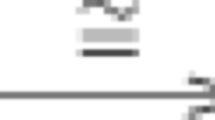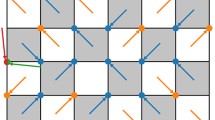Abstract
Quon language is a 3D picture language that we can apply to simulate mathematical concepts. We introduce the surface algebras as an extension of the notion of planar algebras to higher genus surface. We prove that there is a unique one-parameter extension. The 2D defects on the surfaces are quons, and surface tangles are transformations. We use quon language to simulate graphic states that appear in quantum information, and to simulate interesting quantities in modular tensor categories. This simulation relates the pictorial Fourier duality of surface tangles and the algebraic Fourier duality induced by the S matrix of the modular tensor category. The pictorial Fourier duality also coincides with the graphic duality on the sphere. For each pair of dual graphs, we obtain an algebraic identity related to the S matrix. These identities include well-known ones, such as the Verlinde formula; partially known ones, such as the 6j-symbol self-duality; and completely new ones.
Similar content being viewed by others
References
Atiyah M.F.: Topological quantum field theory. Publications Mathématiques de l’IHÉS 68, 175–186 (1988)
Barrett J.: Geometrical measurements in three-dimensional quantum gravity. Int. J. Mod. Phys. A 18(2), 97–113 (2003)
Biamonte J.: Charged string tensor networks. Proc. Natl. Acad. Sci. 114(10), 2447–2449 (2017)
Bisch D.: A note on intermediate subfactors. Pac. J. Math. 163, 201–216 (1994)
Bisch D., Jones V.F.R.: Algebras associated to intermediate subfactors. Invent. Math. 128, 89–157 (1997)
Barrett J.W., Westbury B.W.: Spherical categories. Adv. Math. 143(2), 357–375 (1999)
Coecke B., Kissinger A.: Picturing Quantum Processes: A First Course in Quantum Theory and Diagrammatic Reasoning. Cambridge University Press, Cambridge (2017)
Drinfeld V.G.: Quantum groups. Zapiski Nauchnykh Seminarov POMI 155, 18–49 (1986)
Evans D.E., Kawahigashi Y.: Quantum Symmetries on Operator Algebras, vol. 147. Clarendon Press, Oxford (1998)
Freidel L., Noui K., Roche Ph.: 6j symbols duality relations. J. Math. Phys. 48(11), 113512 (2007)
Gannon T.: Modular data: the algebraic combinatorics of conformal field theory. J. Algebr. Comb. 22(2), 211–250 (2005)
Greenberger, D.M., Horne, M.A., Zeilinger, A.: Going beyond Bell’s theorem. In: Kafatos, M. (ed.) Bell’s Theorem, Quantum Theory and Conceptions of the Universe. Fundamental Theories of Physics, vol. 37. Springer, Dordrecht (1989)
Jaffe A., Liu Z.: Mathematical picture language program. Proc. Natl. Acad. Sci. 115(1), 81–86 (2018)
Jaffe A., Liu Z., Wozniakowski A.: Holographic software for quantum networks. Sci. China Math. 61(4), 593–626 (2018)
Jiang C., Liu Z., Wu J.: Noncommutative uncertainty principles. J. Funct. Anal. 270(1), 264–311 (2016)
Jones, V.F.R.: Planar algebras, I. arXiv:math/9909027
Jones, V.F.R.: The planar algebra of a bipartite graph. In: Knots in Hellas ’98 (Delphi). Series in Knots Everything, vol. 24, pp. 94–117. World Sci. Publ., River Edge (2000)
Jones V.F.R.: Quadratic tangles in planar algebras. Duke Math. J. 161(12), 2257–2295 (2012)
Jones V.F.R., Sunder V.S.: Introduction to Subfactors, vol. 234. Cambridge University Press, Cambridge (1997)
Kawahigashi Y., Longo R., Müger M.: Multi-interval subfactors and modularity of representations in conformal field theory. Commun. Math. Phys. 219(3), 631–669 (2001)
Lafont Y.: Towards an algebraic theory of boolean circuits. J. Pure Appl. Algebra 184(2), 257–310 (2003)
Liu Z.: Exchange relation planar algebras of small rank. Trans. AMS 368, 8303–8348 (2016)
Liu, Z., Morrison, S., Penneys, D.: Lifting shadings on symmetrically self-dual subfactor planar algebras. To appear Contemporary Mathematics arXiv:1709.05023
Longo R., Rehren K.-H.: Nets of subfactors. Rev. Math. Phys. 7(04), 567–597 (1995)
Liu Z., Wozniakowski A., Jaffe A.: Quon 3D language for quantum information. Proc. Natl. Acad. Sci. 114(10), 2497–2502 (2017)
Liu, Z., Xu, F.: Jones-Wassermann subfactors for modular tensor categories (2016). arXiv:1612.08573
Moore G., Seiberg N.: Classical and quantum conformal field theory. Commun. Math. Phys. 123(2), 177–254 (1989)
Müger M.: From subfactors to categories and topology I: Frobenius algebras in and Morita equivalence of tensor categories. Journal of Pure and Applied Algebra 180, 81–157 (2003)
Müger M.: On the structure of modular categories. Proc. Lond. Math. Soc. 87(2), 291–308 (2003)
Ocneanu, A.: Quantized groups, string algebras, and Galois theory for algebras. In: Evans, D., Takesaki, M. (eds.) Operator Algebras and Applications (London Mathematical Society Lecture Note Series), pp. 119–172. Cambridge University Press, Cambridge (1989). https://doi.org/10.1017/CBO9780511662287.008
Robert J.: Skein theory and turaev-viro invariants. Topology 34(4), 771–788 (1995)
Reshetikhin N., Turaev V.G.: Invariants of 3-manifolds via link polynomials and quantum groups. Invent. Math. 103(1), 547–597 (1991)
Turaev V.G.: Quantum Invariants of Knots and 3-manifolds, vol.~18. Walter de Gruyter GmbH & Co KG, Cambridge (2016)
Turaev V.G., Viro O.Y.: State sum invariants of 3-manifolds and quantum 6j-symbols. Topology 31(4), 865–902 (1992)
Tambara D., Yamagami S.: Tensor categories with fusion rules of self-duality for finite abelian groups. J. Algebra 209(2), 692–707 (1998)
Verlinde E.: Fusion rules and modular transformations in 2D conformal field theory. Nucl. Phys. B 300, 360–376 (1988)
Wassermann A.: Operator algebras and conformal field theory III. Fusion of positive energy representations of LSU(N) using bounded operators. Invent. Math. 133(3), 467–538 (1998)
Witten E.: Topological quantum field theory. Commun. Math. Phys. 117(3), 353–386 (1988)
Xu F.: Jones-Wassermann subfactors for disconnected intervals. Commun. Contemp. Math. 2(03), 307–347 (2000)
Acknowledgements
The author would like to thank Terry Gannon, Arthur Jaffe, Vaughan F. R. Jones, Shamil Shakirov, Cumrun Vafa, Erik Verlinde, Jinsong Wu, and Feng Xu for helpful discussions. The author was supported by Grants TRT0080 and TRT0159 from the Templeton Religion Trust and an AMS-Simons Travel Grant. The author would like to thank the Isaac Newton Institute for Mathematical Sciences, Cambridge, for support and hospitality during the programme “Operator algebras: subfactors and their applications”.
Author information
Authors and Affiliations
Corresponding author
Additional information
Communicated by C. Schweigert
Publisher’s Note
Springer Nature remains neutral with regard to jurisdictional claims in published maps and institutional affiliations.
Rights and permissions
About this article
Cite this article
Liu, Z. Quon Language: Surface Algebras and Fourier Duality. Commun. Math. Phys. 366, 865–894 (2019). https://doi.org/10.1007/s00220-019-03361-3
Received:
Accepted:
Published:
Issue Date:
DOI: https://doi.org/10.1007/s00220-019-03361-3




